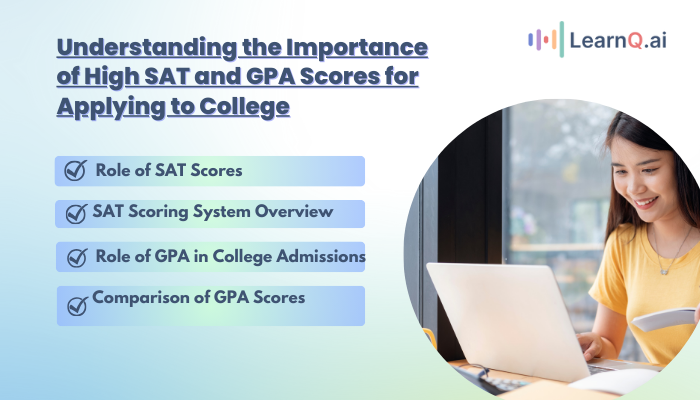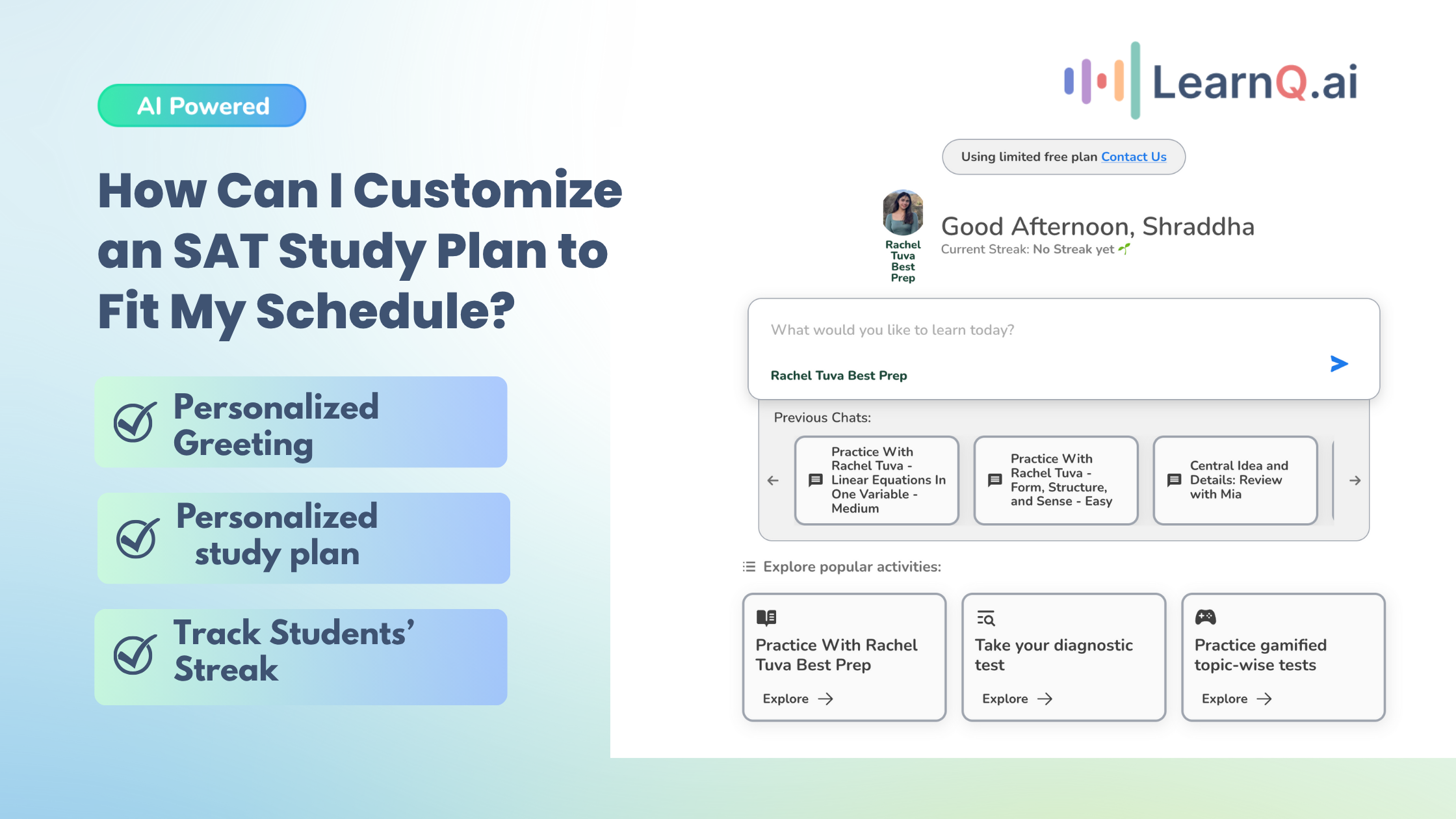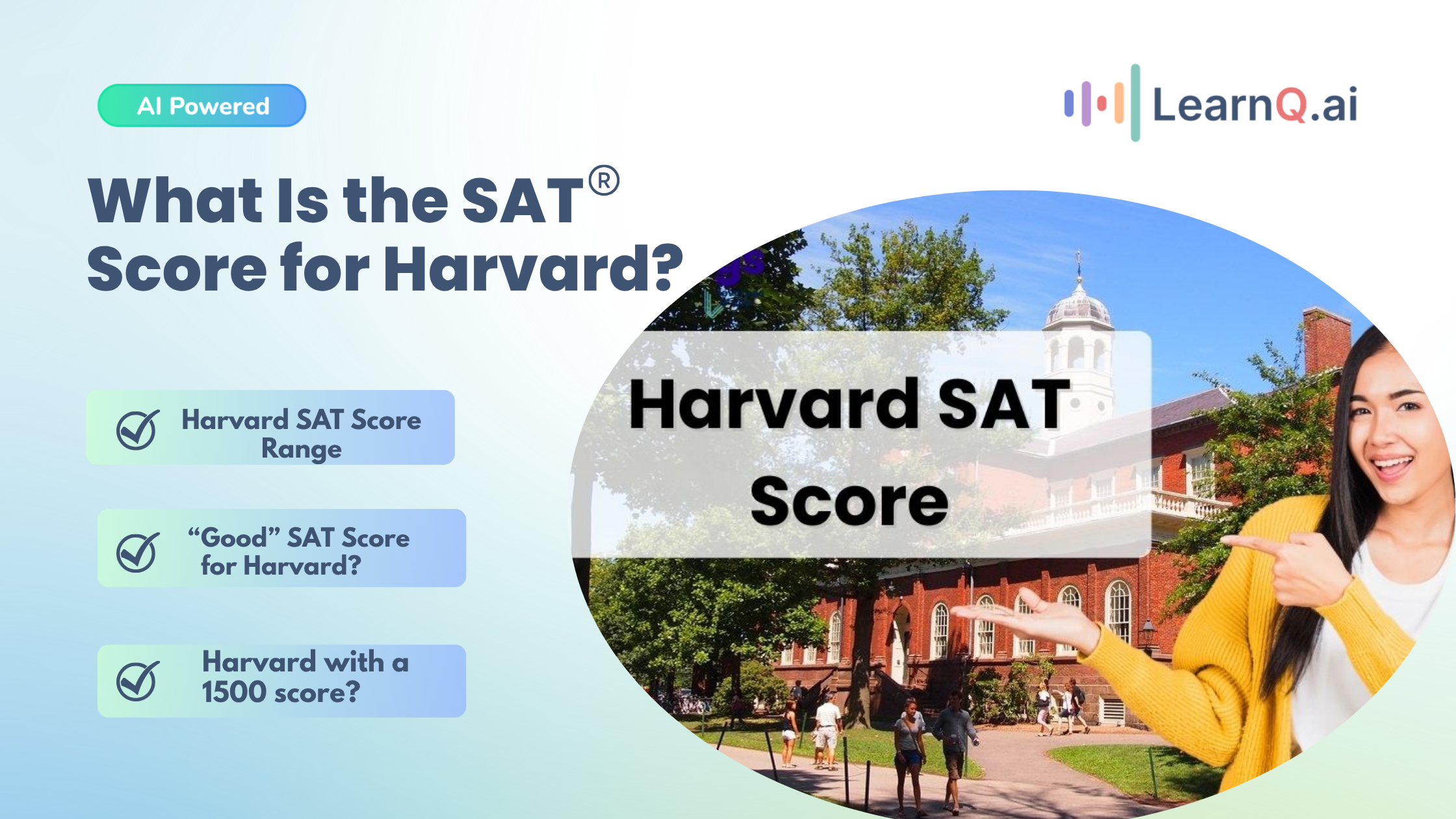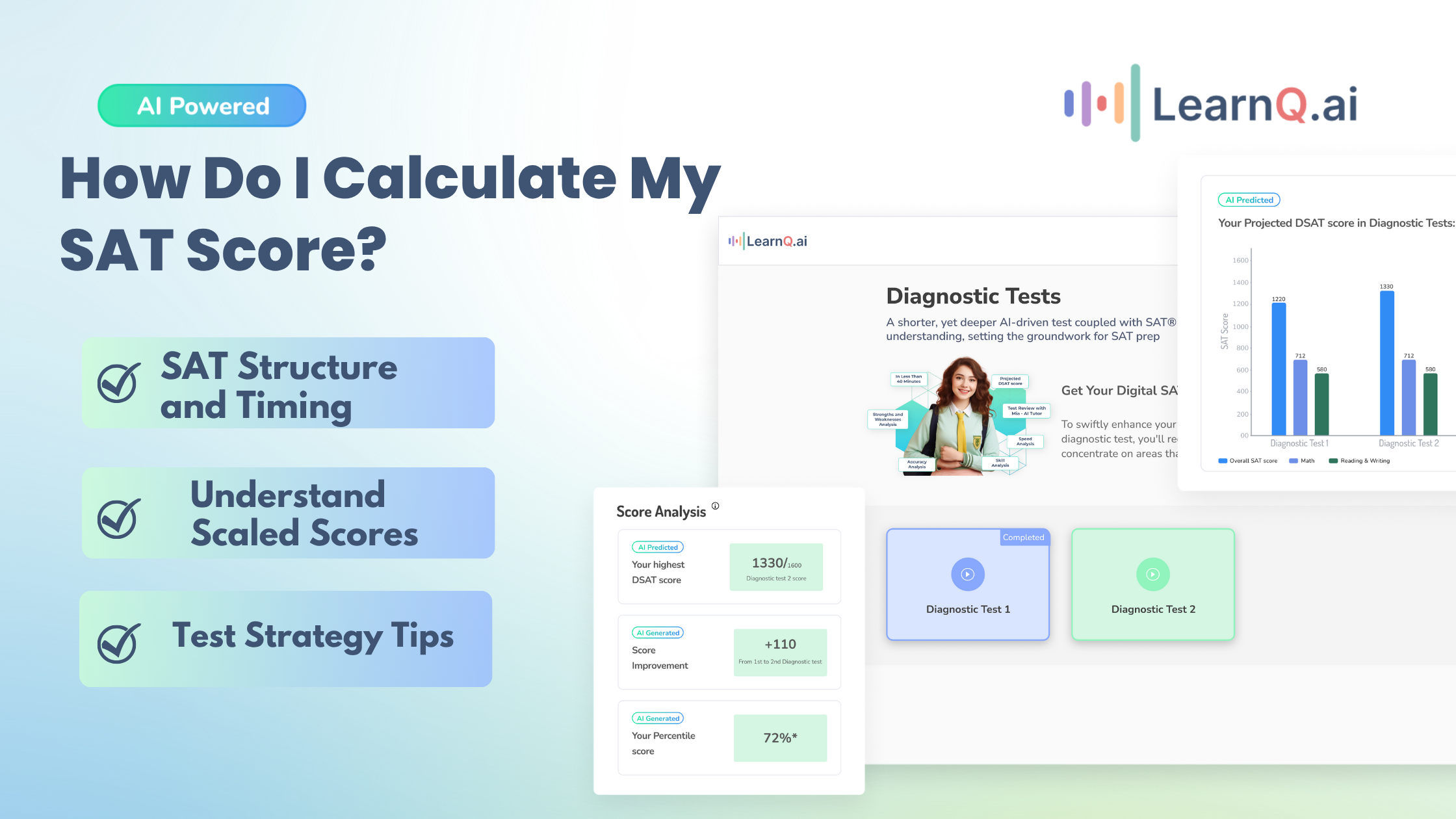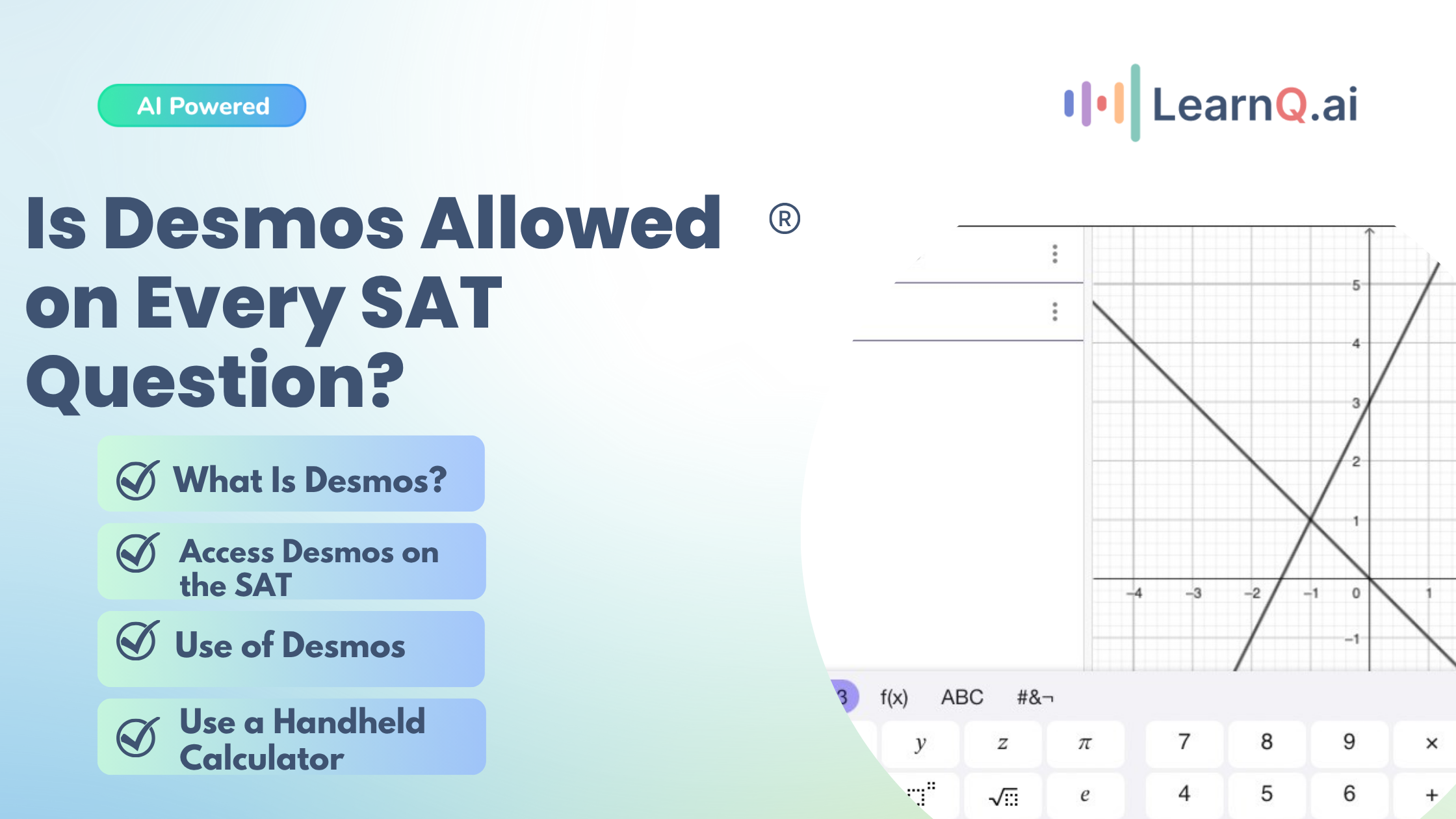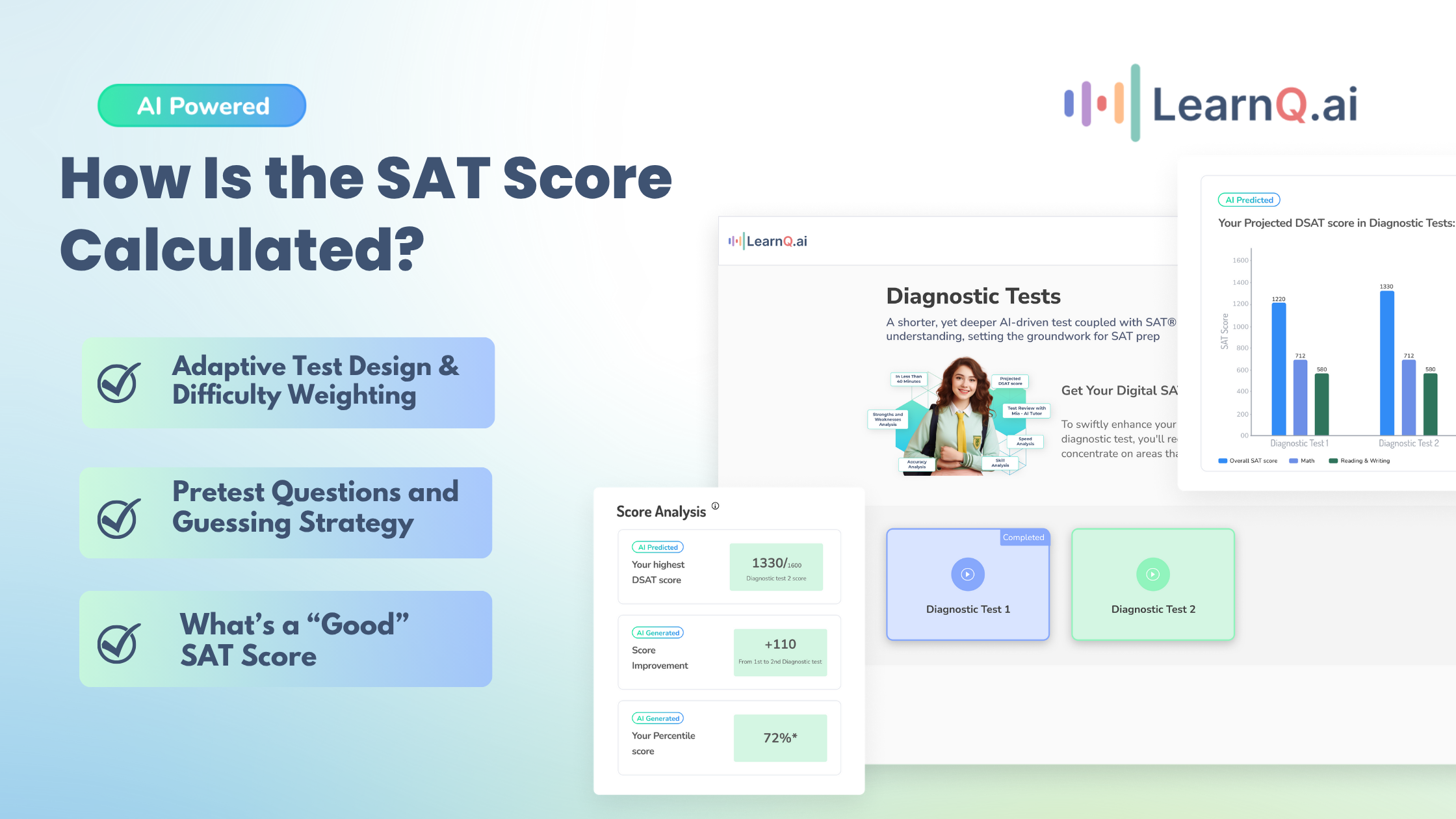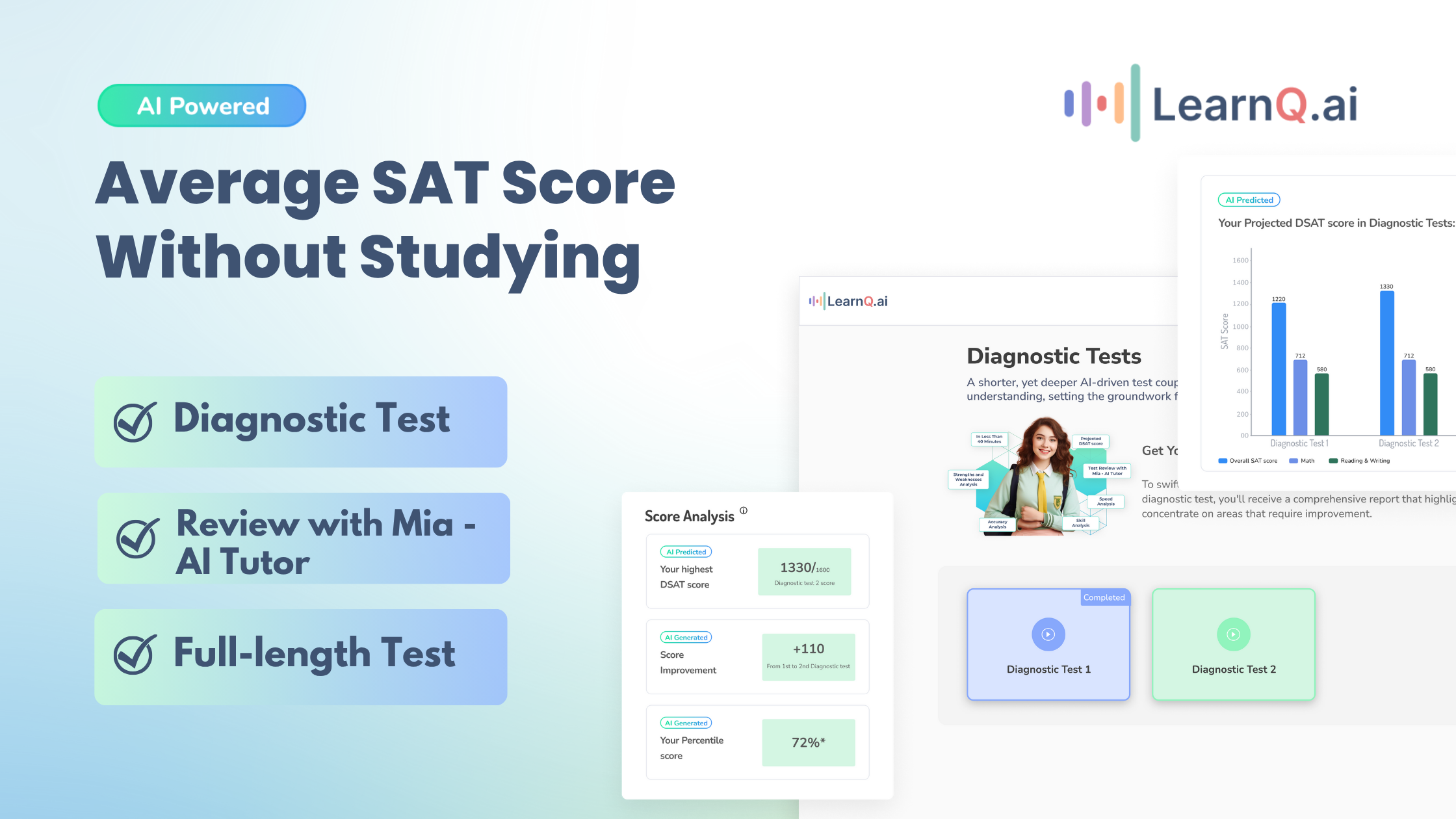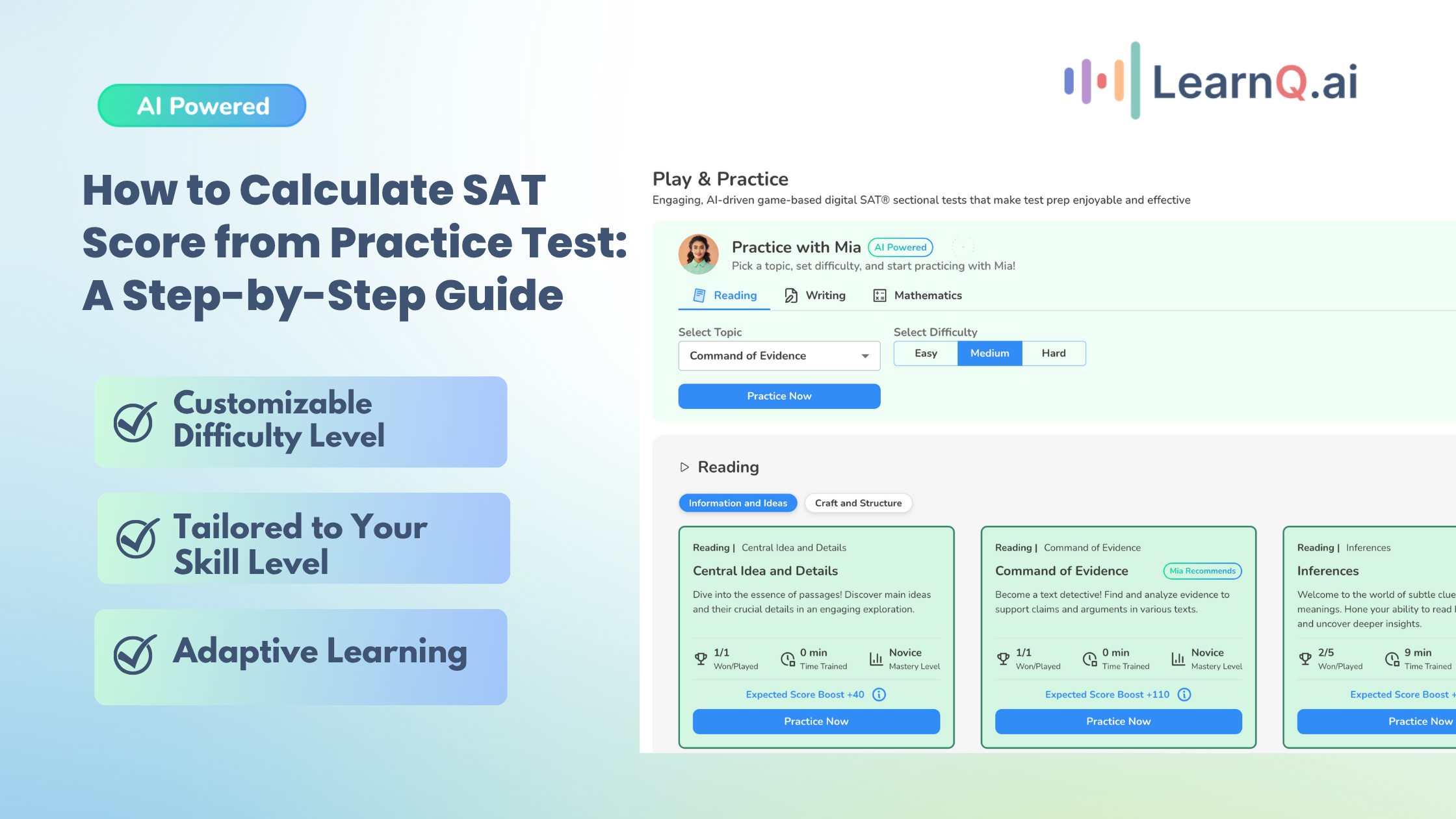As you start thinking about college, two things come to mind: SAT and GPA. For students, parents, and teachers alike, these numbers can feel like the key to opening college doors. But how important are they, really? The truth is that SAT and GPA play critical roles in the college application process.
Colleges look at these scores together to get a complete picture of an applicant’s academic abilities. With high school GPA being the top admissions factor and the average SAT score sitting around 1050, understanding how to excel in both areas can make a big difference in getting into your first-choice school.
Now that you know the importance of SAT and GPA, let’s explore how colleges assess these scores and how you can improve your chances of success.
LearnQ.ai is Powered by VEGA AI—Is your Institute Next?
Give students a Duolingo-style test-prep platform with Shopify-level customization for tutors and institutes.
Role of SAT Scores in College Admissions
SAT scores play a crucial role in shaping a student’s college application. Many institutions use these scores to assess a student’s academic readiness, alongside GPA, to ensure they’re admitting individuals who can handle the rigors of college coursework.
The emphasis on high SAT scores has even sparked a booming test prep industry in the U.S., expected to grow nearly 7% to reach $50 billion by 2027, according to a 2023 report from Technavio.
Let’s dive into how the SAT scoring system works, with a detailed look at the English and Math sections and what score expectations look like across various colleges. You’ll also explore the relationship between GPA and SAT scores and how your GPA can help predict your SAT performance.
SAT Scoring System Overview
The SAT’s digital format, introduced in 2023, has streamlined the test while maintaining a focus on core academic skills. The test consists of two main sections—Reading & Writing and Math—each scored between 200 and 800, for a total score range of 400 to 1600.
The test uses adaptive testing, dividing each section into two modules. The first module features questions of varying difficulty, and based on performance, students receive a tailored second module (easier or harder).
Enhance your Digital SAT study routine with AI-driven insights and personalized practice tests.
Despite the variation in difficulty, the scoring system ensures fairness, allowing students from both modules to achieve the full score range.
Here is the detailed breakdown of the SAT sections.
| Section | Time per Module | Total Time | Question Types | Score Range | College & Career Readiness Benchmark |
| Reading & Writing | 32 minutes | 64 minutes | Mix of easy, medium, and hard reading and writing questions | 200-800 | 480 |
| Math | 35 minutes | 70 minutes | Focus on algebra, geometry, data analysis, and advanced math | 200-800 | 530 |
With the SAT scoring system explained, explore the average score ranges expected by top universities and their role in competitive admissions.
Average SAT Scores and Range Expectations
When aiming for top universities, understanding the typical SAT score range is crucial. The SAT score you need can vary widely depending on the institution, with elite schools generally expecting higher scores. These score ranges reflect the competitive nature of college admissions and help students gauge where they stand in comparison to their peers.
For many top-tier and Ivy League universities, an SAT score above 1500 is often necessary to be considered a strong applicant. Below is a table showcasing the average SAT score ranges for some of the most prestigious universities in the United States.
| University | QS Ranking 2025 | SAT Score Range |
| MIT | 1 | 1520-1570 |
| Harvard University | 4 | 1490-1580 |
| University of Chicago | 21 | 1480-1570 |
| Princeton University | 22 | 1520-1570 |
| Yale University | 23 | 1470-1560 |
| John Hopkins University | 32 | 1520-1560 |
| Columbia University | 34 | 1500-1560 |
| Duke University | 61 | 1450-1570 |
| Brown University | 79 | 1500-1560 |
| Rice University | 141 | 1500-1560 |
Also Read: What is the Highest Score on ACT and SAT Tests?
Relation of GPA with Anticipated SAT Scores
Both SAT scores and high school GPA (HSGPA) are widely recognized as important predictors of a student’s success in college, particularly in relation to college GPA (CGPA).
Studies, such as Betts and Morrell (1999), show a clear correlation between these academic factors. Their findings indicate that while SAT scores and HSGPA together help predict CGPA, the impact of HSGPA on college performance is more modest than you might expect. For example, a one-point increase in HSGPA is associated with only a 0.053-point increase in CGPA.
How GPA Predicts SAT Performance?
While GPA reflects a student’s consistent effort across various subjects and over time, SAT scores tend to measure a student’s aptitude in a more focused, test-specific environment. Here’s how GPA can help predict SAT performance:
- Higher GPA, Strong Academic Foundations: Students with higher GPAs generally have stronger foundational knowledge, which often translates into better SAT scores. Consistency in academic performance across subjects usually indicates readiness for the types of questions on the SAT.
- Work Ethic and Test Preparation: A strong GPA may suggest that a student has good study habits, time management, and discipline, all of which are essential when preparing for standardized tests like the SAT.
- Limitations: However, it’s important to recognize that GPA doesn’t directly predict SAT scores. The SAT tests specific reading, writing, and math skills that may not directly align with a student’s GPA, which covers a broader range of subjects.
GPA vs. SAT Score Comparison
To provide a clearer understanding, here’s a general comparison between GPA ranges and the corresponding anticipated SAT score ranges. While this isn’t a strict rule, it offers a useful guide for students, parents, and educators.
| GPA Range | Anticipated SAT Score Range |
| 4.0 (A+) | 1450-1600 |
| 3.7 – 3.9 (A) | 1350-1450 |
| 3.3 – 3.6 (B+) | 1250-1350 |
| 3.0 – 3.2 (B) | 1150-1250 |
| 2.5 – 2.9 (C+) | 1000-1150 |
| Below 2.5 (C and below) | Below 1000 |
Role of GPA in College Admissions
GPA plays a vital role in the college admissions process, often serving as a key indicator of a student’s academic achievements over time. Unlike standardized test scores, GPA reflects a student’s consistency, work ethic, and ability to handle various subjects.
Colleges use GPA to assess not only your academic potential but also how well you’ve performed in relation to your peers. However, comparing GPAs across different schools and educational systems presents unique challenges.
Explore the significance of GPA as a long-term performance measure and how advanced classes like AP or IB impact your college readiness.
Importance of GPA as a Measure of Academic Achievements
GPA is a key measure of academic achievements, offering a snapshot of a student’s performance over time. It reflects consistency, dedication, and mastery across various subjects.
- Consistency in Performance: Shows sustained effort throughout high school.
- Broader Academic Ability: Captures performance across multiple subjects, unlike standardized tests.
- Predictor of College Success: A higher GPA often indicates readiness for the demands of college coursework.
- Long-Term Dedication: Demonstrates commitment and time management skills over several years.
Comparison of GPA Scores Across Different High Schools
Comparing GPA scores across high schools presents several challenges due to differences in grading policies, available courses, and educational systems. High schools can vary in their use of weighted GPAs (which give extra points for honors, AP, or IB courses), grading scales, and the difficulty of their curriculum.
As a result, two students with the same GPA might have very different academic experiences and capabilities, depending on their school’s grading practices and course rigor.
Here are the challenges in comparing GPAs:
- Weighted vs. Unweighted GPA: Some high schools offer weighted GPAs, adding extra points for advanced courses, while others do not. This makes direct comparisons difficult.
- Different Grading Scales: Some schools use a 4.0 scale, while others employ a 5.0 or even 12-point scale, which affects how GPA is calculated and interpreted.
- Course Rigor and Offerings: Some schools offer more advanced courses (e.g., AP or IB programs), which can boost GPAs, while others have limited advanced course options.
- Regional Variations: Grading standards can vary by state, district, or country, making it hard to assess GPAs on a national or international scale.
1. Weighted vs. Unweighted GPA
GPAs are measured in two ways: weighted and unweighted. Unweighted GPAs treat all courses equally, while weighted GPAs give extra points for advanced classes like AP or IB. Understanding these differences helps accurately reflect both performance and course difficulty.
| GPA Type | Description | Max Score |
| Unweighted | Standard GPA without extra points for advanced courses | 4.0 |
| Weighted | Adds extra points for honors, AP, or IB courses | 5.0+ |
2. Grading Scale Variations
Grading scales differ across high schools, which can complicate the comparison of GPAs. Some schools use unweighted systems, while others apply weighted scales to account for advanced courses. These variations make it essential to understand how GPAs are calculated to assess academic performance accurately.
| School Grading Scale | Description | Example GPA Range |
| 4.0 Scale | Commonly used in U.S. schools | 0.0 – 4.0 |
| 5.0 Scale | Used for schools with weighted courses | 0.0 – 5.0 |
| 12-point Scale | Less common, used in some international schools | 0.0 – 12.0 |
3. Impact of Advanced Courses (AP/IB) on GPA
Taking advanced courses like AP and IB can significantly impact GPA, offering both academic advantages and challenges. These courses not only boost GPA but also highlight a student’s readiness for college-level work.
| Course Type | Weighted GPA Boost | Example GPA Boosted |
| Standard Course | No additional points | 4.0 (max) |
| AP/IB Course | Adds 0.5-1.0 points | 4.5-5.0 (max) |
Impact of Advanced Classes on GPA Assessment
Taking AP (Advanced Placement) or IB (International Baccalaureate) courses can significantly affect a student’s GPA and college readiness. These advanced classes are designed to challenge students beyond the standard high school curriculum, often offering weighted GPA benefits and better preparation for college-level work.
- Weighted GPA Boost
AP and IB courses often come with the benefit of a weighted GPA, where students can earn more than the standard 4.0 for high grades. For instance, an “A” in an AP/IB class may be worth 5.0, compared to the typical 4.0 for the same grade in a regular course. This weighted boost helps students reflect the extra effort and challenge involved in these advanced courses, ultimately raising their overall GPA.
- Increased Competitiveness
Colleges understand the difficulty and rigor of AP/IB classes, making students who take these courses stand out in the admissions process. A higher GPA earned from these challenging courses signals to colleges that the student is well-prepared for the academic demands of college. This added competitiveness can give students an edge, especially in selective college admissions.
- GPA Differentiation
AP and IB classes also help differentiate students academically. Since these courses allow for a GPA higher than 4.0, students who perform well can achieve GPAs that exceed those of their peers in regular courses. This differentiation becomes critical when applying to competitive colleges, as it showcases a student’s ability to excel in advanced academic environments.
Holistic Admissions Factors in Ivy League Applications
Ivy League schools take a holistic approach to admissions, meaning they look beyond just SAT and GPA. While these scores are important, they are considered alongside other critical factors such as leadership roles, extracurricular activities, personal essays, and letters of recommendation. This comprehensive review allows schools to assess the applicant as a whole, focusing on their potential to academically and personally contribute to the campus community.
Combining SAT and GPA
In Ivy League applications, strong SAT scores can complement or enhance a high GPA, creating a more well-rounded academic profile. For instance, if a student’s GPA is slightly lower, a high SAT score can demonstrate their academic aptitude and ability to perform under pressure.
Conversely, if a student has a strong GPA but a lower SAT score, the consistent academic performance reflected in the GPA may still provide confidence in the student’s readiness for college. The key is for both scores to align with the high standards expected by these prestigious institutions.
Tailoring Prep: Aligning SAT and GPA with College-Specific Criteria
Each Ivy League school has its own set of expectations and admissions criteria. When preparing for college applications, it’s essential to tailor your SAT prep and academic efforts to match the specific standards of your target schools.
Enhance your Digital SAT study routine with AI-driven insights and personalized practice tests.
For example, some universities might place more emphasis on SAT math scores for STEM-focused programs, while others may value leadership and extracurriculars more. By aligning your SAT and GPA goals with the preferences of your desired schools, you can position yourself as a strong candidate across all areas of evaluation.
Financial Aid and Scholarship Opportunities
Achieving a high GPA and SAT scores can greatly enhance your eligibility for merit-based financial aid and scholarships. Many colleges and private organizations rely on these scores as a primary factor in scholarship decisions.
High scores can significantly enhance students’ chances of receiving financial aid, making it essential for them to excel on the test to optimize their funding opportunities.
Impact on Scholarships
Boosting your scores strengthens your college application and can significantly improve your chances of securing scholarships. Many merit-based scholarships require applicants to meet or exceed specific score thresholds.
A higher SAT score or GPA can make you eligible for larger awards, reducing the financial burden of tuition and other college expenses.
Additionally, some schools offer automatic scholarships based on SAT scores, providing an immediate reward for strong performance.
Scholarships Based on SAT GPA Scores
High SAT and GPA scores strengthen college applications and open the door to valuable scholarship opportunities.
Many merit-based scholarships consider SAT and GPA scores as a key factor in awarding financial aid, making it essential for students to perform well on the test to increase their chances of receiving support. Here’s a look at some top scholarships that take SAT scores into account.
| Scholarship Program | Award Amount |
| Coca-Cola Scholars Program | Up to $20,000 |
| Dell Scholars Program | Up to $20,000 + support |
| Elks National Foundation Most Valuable Student Scholarship | $1,000 to $7,500 annually |
Strategies for SAT Score Improvement
Here are some effective tactics to improve SAT scores and increase your chances of qualifying for scholarships:
- Seek Expert Guidance: Consider enrolling in SAT prep courses or working with a tutor to get personalized instruction and strategies.
- Consistent Practice: Regularly use SAT prep tools, such as LearnQ’s adaptive digital practice tests, to target your weak areas and build confidence.
- Focus on Weak Subjects: Identify areas where you need improvement, whether it’s math, reading, or writing, and dedicate extra time to those sections.
- Review Mistakes: Analyze the questions you got wrong to understand your mistakes and learn from them.
- Full-length SAT Practice Tests: Taking full-length SAT practice tests helps you build stamina and get familiar with the test format.
Also Read: SAT Punctuation Rules: Tips for Commas, Dashes, and Colons.
Strategies for GPA Score Improvement
Improving your GPA requires a focused approach and dedication to consistent academic performance. Here are some effective strategies to enhance your GPA:
- Attend All Classes: Ensure regular attendance to grasp the material and participate in discussions.
- Stay Organized: Use planners to track assignments, tests, and deadlines.
- Develop Good Study Habits: Create a study schedule and break sessions into manageable chunks.
- Actively Participate in Class: Engage in discussions and ask questions for deeper understanding.
- Utilize Available Resources: Take advantage of tutoring services, study groups, and academic workshops.
- Seek Help When Needed: Don’t hesitate to ask teachers or peers for clarification on difficult topics.
- Focus on High-Impact Courses: Choose advanced courses that can boost your GPA with weighted scores.
- Set Realistic Goals: Establish achievable academic targets for each grading period.
- Review and Reflect: Analyze grades to understand strengths and weaknesses for future improvement.
LearnQ.ai is powered by VEGA AI—Is your institute next?
Offer students a Duolingo-style test-prep platform with Shopify-level customization for tutors and institutes.






Conclusion
In the competitive realm of college admissions, SAT scores and GPA are crucial indicators of a student’s academic potential. They not only highlight your abilities but also enhance your chances of securing scholarships and financial aid.
To effectively boost students’ SAT and GPA, cultivate strong study habits, seek expert support, and use available resources such as practice tests and high-impact courses.
As you get through your college application journey, use tools like LearnQ.Ai for personalized SAT prep and diagnostics. With our AI-driven tutor, you’ll receive tailored support every step of the way, ensuring you’re fully prepared for test day. Start your journey with LearnQ.ai and maximize your SAT potential today!

